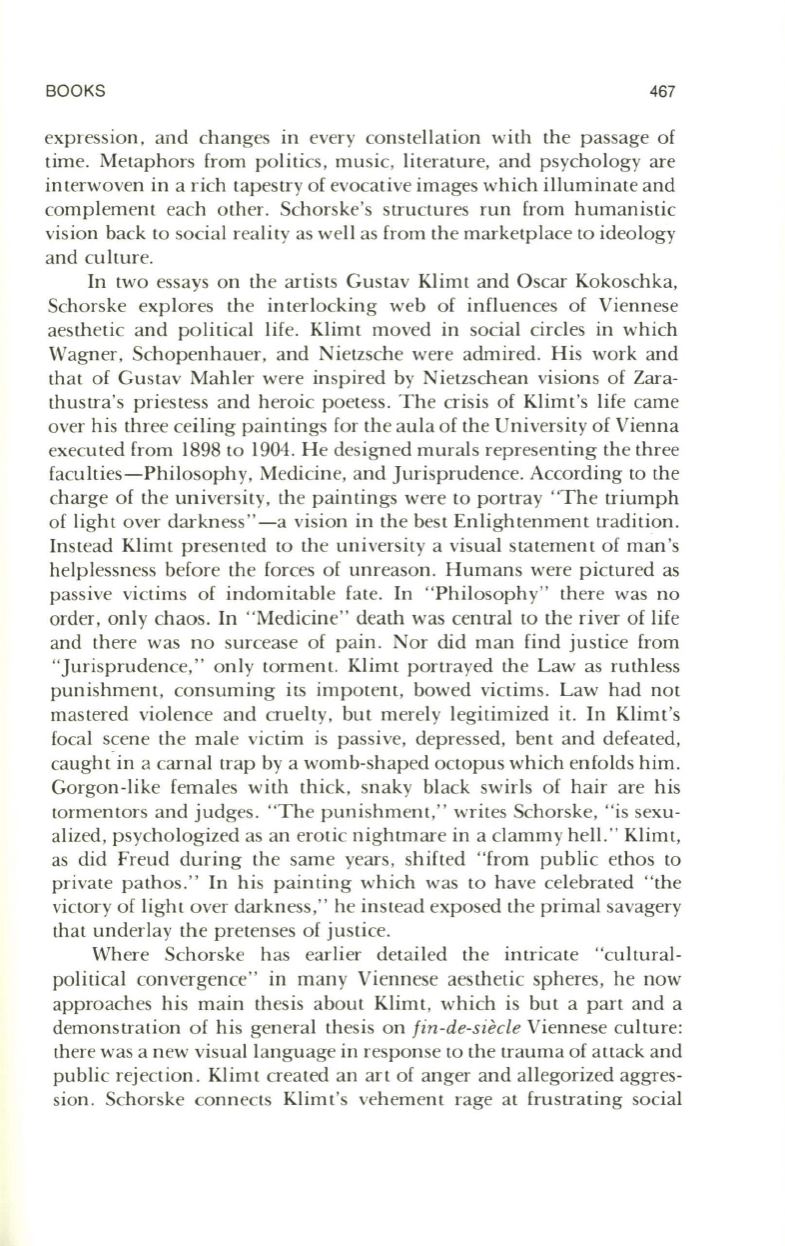
BOOKS
467
expression, and changes in every constellation with the passage of
time. Metaphors from politics, music, literature, and psychology are
interwoven in a rich tapestry of evocative images which illuminate and
complement each other. Schorske's structures run from humanistic
vision back to social reality as well as from the marketplace to ideology
and culture.
In two essays on the artists Gustav Klimt and Oscar Kokoschka,
Schorske explores the interlocking web of influences of Viennese
aesthetic and political life. Klimt moved in social circles in which
Wagner, Schopenhauer, and Nietzsche were admired. His work and
that of Gustav Mahler were inspired by Nietzschean visions of Zara–
thustra's priestess and heroic poetess. The crisis of Klimt 's life came
over his three ceiling paintings for the aula of the University of Vienna
executed from 1898 to 1904. He designed murals representing the three
faculties-Philosophy, Medicine, and Jurisprudence. According to the
charge of the university, the paintings were to portray 'The triumph
of light over darkness"-a vision in the best Enlightenment tradition.
Instead Klimt presented to the university a visual statement of man's
helplessness before the forces of unreason. Humans were pictured as
passive victims of indomitable fate. In "Philosophy" there was no
order, only chaos. In "Medicine" death was central to the river of life
and there was no surcease of pain . Nor did man find justice from
"Jurisprudence," only torment. Klimt portrayed the Law as ruthless
punishment, consuming its impotent, bowed victims. Law had not
mastered violence and cruelty, but merely legitimized it. In Klimt's
focal scene the male victim is passive, depressed, bent and defeated,
caught-in a carnal trap by a womb-shaped octopus which enfolds him.
Gorgon-like females with thick, snaky black swirls of hair are his
tormentors and judges. "The punishment, " writes Schorske, "is sexu–
alized, psychologized as an erotic nightmare in a clammy hell." Klimt,
as did Freud during the same years, shifted "from public ethos to
private pathos. " In his painting which was to have celebrated "the
victory of light over darkness, " he instead exposed the primal savagery
that underlay the pretenses of justice.
Where Schorske has earlier detailed the intricate "cultural–
political convergence" in many Viennese aesthetic spheres, he now
approaches his main thesis about Klimt, which is but a part and a
demonstration of his general thesis on
fin-de-siecle
Viennese culture:
there was a new visual language in response to the trauma of attack and
public rejection . Klimt created an art of anger and allegorized aggres–
sion. Schorske connects Klimt's vehement rage at frustrating social


